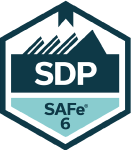Overview
Cprime’s Certified SAFe® DevOps Practitioner (SDP) training course provides a comprehensive overview for understanding the DevOps competencies needed to accelerate time-to-market by improving the flow of value through the Continuous Delivery Pipeline.
Outcomes of Cprime’s SDP certification training course include:
- Understanding what the CALMR approach to DevOps is, why it is so important, and the ability to explain it to others
- Understanding the importance of continuous integration, continuous testing, and be ready to apply it
- The ability to apply the concepts of continuous security
- Mapping your current delivery pipeline
- The ability to measure the flow of value through the delivery pipeline
- Improved processes for exploring customer needs
- Improved release processes
- Improved development, building, and continuous integration processes
- Optimized continuous deployment processes for staging and production environments
- The ability to execute an action plan for a DevOps transformation
Your teams will leave with the tools they need to execute an implementation plan for improving their delivery pipeline, and the knowledge they need to support the plan.
*Cprime is proud to be a Gold SPCT and Platform Level partner with Scaled Agile, the exclusive certifying body for the Scaled Agile Framework. Attending this class and passing the qualifying exam will earn you the SAFe DevOps Practitioner (SDP) certification.

The first step toward becoming a Certified SAFe® DevOps Practitioner is to attend the SAFe® 6 DevOps Practitioner course. This is a requirement, because attending the course provides access to all the study materials and the exam. Note that attending the course does not guarantee passing the exam.
GSA: $726.35 USD
15 PDUs
Next Upcoming Course


Train up your teams with private group training
Have a group of 5 or more students? Cprime also provides specialist private training with exclusive discounts for tailored, high-impact learning.
Certified SAFe® DevOps Practitioner (SDP) Schedule
Full Course Details
- Introducing DevOps
- Mapping your Continuous Delivery Pipeline
- Gaining alignment with Continuous Exploration
- Building quality with Continuous Integration
- Reducing time-to-market with Continuous Deployment
- Delivering Business Value with Release on Demand
- Taking action
- Members of an Agile Release Train
- Development Managers, Engineering Managers
- Configuration Managers, Release Managers
- Development Leads, Developers, UI/UX Developers
- Infrastructure Architects, System Architects
- Product Managers, Product Owners
- System Administrators, DBAs, InfoSec
- QA Managers, Testers
- Release Train Engineers, Scrum Masters
- Understand what the CALMR approach to DevOps is, why it is so important, and be able to explain it to others
- Understand the importance of continuous integration, continuous testing, and be ready to apply it
- Apply the concepts of continuous security
- Map the current delivery pipeline
- Measure the flow of value through the delivery pipeline
- Improve the process of exploring customer needs
- Improve the release process
- Improve the process of developing, building, and integrating continuously
- Improve the process of continuously deploying to staging and production environments
- Execute an action plan for a DevOps transformation
- Exam name – SAFe® 6 DevOps Practitioner Exam
- Exam format – Multiple choice (one answer) or multiple select (2-3 answers)
- Exam delivery – Web-based (single-browser), closed book, no outside assistance, timed
- Exam access – Candidates can access to the exam within the SAFe Community Platform upon completion of the SAFe® DevOps Practitioner course
- Exam duration – Once the exam begins, candidates have 90 minutes (1.5 hours) to complete the exam.
- Number of questions – 45
- Passing score – 33 out of 45 (73%)
- Language – English
- Exam cost – First exam attempt is included as part of the course registration fee if the exam is taken within 30 days of course completion. Each retake attempt costs $50.
- Retake policy – Second attempt on exam (first retake) can be done immediately after first attempt. Third attempt requires a 10-day wait. Fourth attempt requires a 30-day wait.
